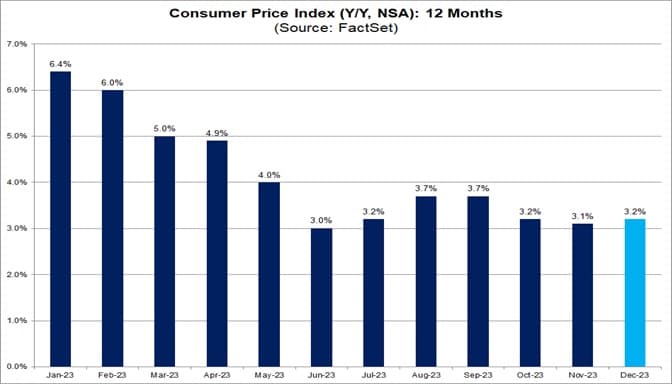What is the US CPI?
The US Consumer Price Index (CPI) tracks the average change in prices paid by urban consumers for a variety of goods and services. It’s a dynamic basket that includes your morning coffee, the rent for your urban sanctuary, the cost of a new gadget, and even the indulgence of a streaming service.
Crucially, the CPI isn’t just about the price of one thing; it takes the basket of goods into account as a comprehensive snapshot of your overall cost of living. It captures the subtle shifts in prices that, when combined, paint a vivid picture of how your hard-earned Dollars (Euros, Pounds etc) are performing in the economic landscape.
Why Should You Care About the US CPI?
The CPI is not just a bunch of statistics; it’s your financial crystal ball. When it rises, it’s like the economy whispering in your ear, saying, “Hey, costs are climbing, be prepared.” It’s the heads-up you need to adjust your budget, whether that means cutting back on the weekend brunch or thinking twice about that impulse buy.
In this way, CPI impacts your daily and long term plans. Thinking of a vacation? Rising CPI might mean pricier flights and hotel stays. Contemplating a major purchase? It could affect interest rates. In essence, the CPI isn’t just about numbers; it’s about the very real impact on your day-to-day life.
Why is it Particularly Crucial Right Now?
Recent years have been a roller-coaster for inflation. We’ve seen prices skyrocket, making every US Dollar in your pocket feel like it’s shrinking. But now, it’s like we’re catching a breath. The economy is cooling down from its inflationary highs, and that’s where the CPI takes centre stage. It’s not just about looking back at the chaos; it’s about understanding where we’re headed.
With inflation showing signs of simmering down, this CPI report becomes your guide for what’s next. Whether you’re a seasoned investor wondering when the next Central Bank rate cuts will be and what to target, or a budget-conscious shopper, or just someone curious about the economic landscape, the CPI is crucial to what may come next. So, as we approach this release, keep your financial radar on, because the CPI is about to reveal the economic script for the next act.
US CPI Expectations
As anticipation builds for the forthcoming December Consumer Price Index (CPI) report, investors are scrutinising the forecasts that could potentially steer the trajectory of interest rates. The projections paint a nuanced picture, hinting at a modest increase in overall inflation, albeit with a positive twist once the variable elements of food and energy costs are accounted for. Consensus forecasts a 3.2% annual growth rate in December, slightly surpassing November’s 3.1%. On a monthly scale, a 0.2% growth is anticipated, up from November’s 0.1%. Despite a downward trend in prices since the start of 2023, many experts believe the Federal Reserve won’t hit its 2% inflation target until late 2024 or early 2025.

Recent job data fluctuations, though momentarily unsettling, indicate a gradual slowdown in the labour market. This suggests that the Federal Reserve’s interest rate hikes over the past two years have not inflicted significant harm on the broader economy.
As Thursday’s CPI report approaches, the focus is on an overall inflation reading between 3.2% and 3.3%, with core CPI expected to range from 3.8% to 3.9%. While retailers discontinuing holiday discounts might cause a slight uptick, we don’t see this altering the Fed’s established course. The overarching theme remains: inflation has slowed notably faster than the Federal Reserve anticipated. The unveiling of the CPI numbers holds significance beyond statistics, offering clues that could shape the future of interest rates and influence our economic landscape. Keep an eye on the CPI and its potential impacts!